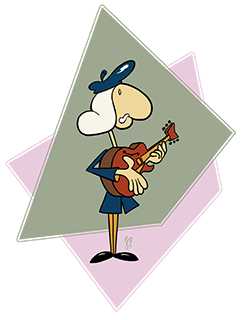What Jens has done is taken all the notes of C major on the 'B' string and 'harmonized' three-note voicings for D-7, G7, Cmaj and A7b9. Another lesson shows the same concept formatted for F major, with additional chords to navigate the high 'E' string. I've diagrammed both to visualize on the fretboard in the PDF.
| chordscaleharmonized.pdf |
My strategy for learning and applying this stuff for the Cmaj turnaround has gone like this:
1) First, I need to know all the notes of Cmaj on the B-string. I set up the turnaround -- Cmaj7 / A7b9 / D-7 / G7 -- in a loop and practice making turnaround licks -- playing only on the 'B' string. After a while I started practicing octaves to drill the idea home more, thinking about the top note on the 'B' string as the 'melody' note.
2) Next I systematically learned each 'chord-scale' by rote. I learn this scale with the same strategies as any other scale. First learn to play it up the neck, then down the neck. Then I start skipping around in systematic ways, like play the first voicing, then the third, then the second, then the fourth, etc. When I'm learning the scale, I'm constantly reminding myself "This is the D-7 chord scale" and try and pick out roots and ECTs as I move.
3) After that I made a backing loop for one chord and moved up and down the corresponding scale freely improvising. I started to get a feel where the ECTs were for each chord. I would also occasionally hang on a voicing and try and locate where I was on the Cmajor scale, playing other surrounding notes in C major to make sure I had a picture of that scale underneath my voicing.
4) Next I plugged in the the same turnaround into my iReal software, except with enough measures on each chord to systematically do the chord-scale in both directions.
5) At this point, I felt ready to tackle some of the turnaround examples in the lessons Jens provided.
6) Finally I began to noodle around in the same way as in step 1, except instead of playing an octave, I was playing a chord-scale triad from whatever chord I was on. If I felt I was getting ahead of myself, I would go back to the other steps to make sure I knew all the voicings and could shift between chord-scales.
It's been a blast playing these chord-scales over the turnaround. I began to get a feel for which voicings are 'passing-chords' and which are better to land on. Soon, I'm going to check out the other video lessons by Jens and learn voicings he constructed for F major, including voicings for the high 'E' string. After that, I'm going to start moving to other keys and maybe try constructing chord-voicings for minor turnarounds.

 RSS Feed
RSS Feed
